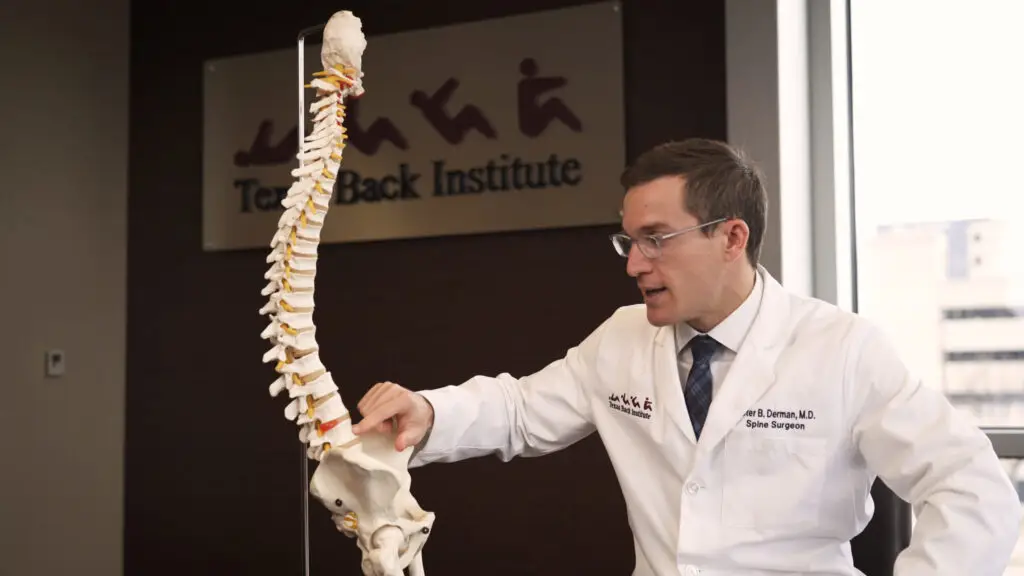Everything You Need to Know About an Annular Tear of a Vertebral Disc
how we can help
Annular Tear Overview
An annular disc tear is a tear in the outer ligamentous ring of intervertebral discs. These discs act as shock absorbers in the spine, cushioning the vertebrae during movement. High-impact activities and trauma can lead to increased pressure on these discs, resulting in annular disc tears. Imagine the disc as a jelly-filled donut; when pressure is applied, the jelly inside helps maintain the donut’s shape despite any tears in the outer layer. Similarly, the inner gel-like substance of the disc helps maintain its integrity even when the outer ring is compromised.
With more than three million people a year being diagnosed and treated for a herniated or bulging disk, the chances are good that you, or someone you know, has dealt with the discomfort and often relentless pain of this condition. These disks or cushions found between vertebrae in the spinal column withstand immense pressure from the activities of everyday life – walking, running, lifting, working, and hundreds of other simple tasks, and when damage occurs to them, it can be painful.
An annular tear refers to a fissure or crack in the annulus fibrosus, which forms the thick outer layer of a vertebral disk. Over time, this condition can lead to a herniated disk, where the gel-like substance inside the disk leaks through the weakened disk wall.
In the section of the Texas Back Institute website on herniated disks, “the vertebral column provides protection to the spinal cord that runs through its central cavity. Between each vertebra is an intervertebral disk. The disks are filled with a gelatinous substance, called the ‘nucleus pulposus,’ which provides cushioning to the spinal column. The annulus fibrosus is a fibrocartilaginous ring that surrounds the nucleus pulposus, which keeps it intact when forces are applied to the spinal column. The intervertebral disks allow the vertebral column to be flexible and act as ‘shock absorbers’ during everyday activities such as walking, running, and jumping.”
An annular tear, also known as an annular fissure, can cause pain, reduced mobility, and nerve compression. The annulus fibrosus is a protective ring around the disc, and when it tears, it can be painful due to the many nerve fibers present in the outer third of the annular ring. No disc material is ruptured when an annular tear occurs, but the condition can still cause significant discomfort and potential for future injuries.
The definition of the word annular is from the Latin word “annularis.” which means “ring-like.” Composed mainly of fibrocartilage, the annulus fibrosus is made up of concentric layers of collagen fibers arranged in a circular fashion. These overlapping layers provide support essential to spinal stability while allowing controlled movement between adjacent vertebrae.
Unfortunately, this important part of the structural integrity of the intervertebral disk is susceptible to wear and tear over time due to conditions like degenerative disk disease or from an injury.
Table of Contents
Symptoms
Diagnosing
Treatments
Patients Ask:
Can an Annular Tear Heal on Its Own?
Texas Back Institute Responds: An annular tear can heal without medical intervention if scar tissue forms over the torn area, assisting in the healing process. However, because the outer third of the annular ring contains numerous nerve fibers, an annular fissure can be quite painful. While it may heal over time, the scar tissue will not be as strong as the original annular fibers, so it remains vulnerable to future tears and injury. Conservative treatments, which are non-surgical methods aimed at alleviating pain and promoting healing for annular tears, can help manage symptoms and support recovery.
What Causes Annular Fissures?
A condition known as spondylosis, age-related degenerative changes in the spine, plays a significant role in the cause of annular fissures. Over time, the intervertebral disk is subject to disk desiccation, which is the dehydration – or drying out – of the disks between the spinal vertebrae. The desiccation of intervertebral disks can cause the disks to flatten out, increasing pressure on the disks that may affect the spinal nerves.
Other common causes of annular fissures are occupations that require repetitive motions like heavy lifting or constant bending, high impact sports activities like football or rugby, and increased body weight. Even a healthy, well-hydrated disk can be injured. Additionally, Excess body weight can place additional stress on the discs, increasing the likelihood of injury and resulting pain.
Stretching or tearing of the annulus may result in back or neck pain. The disks are immediately in front of the spinal cord and exiting nerves, so when the herniated disk or protrusion compresses the spinal cord or nerves, leg or arm pain and numbness or weakness may occur.
Without the support of spinal discs, the spinal vertebrae can begin to rub together. Over time, the spine can show more signs of wear and tear – resulting in further damage to the vertebrae. Small bony growths called bone spurs, which are extremely painful, may form because of this prolonged irritation.

Patients Ask:
Is an Annular Tear the Same as A Herniated Disk?
Texas Back Institute Responds: Though similar, these are two different conditions. An annular tear, a small rip in the annulus fibrosus, can be the result of a weakened or brittle disk due to disk dehydration over time. Disc tears develop due to natural degeneration, trauma, or repetitive strain, leading to significant spinal pain and potential complications. In some cases, these small fissures or tears will not result in noticeable symptoms. However, if the pressure on the disk causes the inner gel-like contents to push through the tear and escape into the spinal canal, this is known as a herniated disk.
What is a Bulging Disk?
Spinal disk herniation, which is also referred to as a “slipped disk,” “ruptured disk” or more commonly as a “bulging disk,” occurs when the soft center of a spinal disk pushes through a crack in the tougher exterior casing, the annulus fibrosus. Spinal discs play crucial roles in supporting vertebrae, absorbing shock, and allowing flexible movement of the spine. Most bulging disks occur in the low (lumbar region) back area. This condition is very common and may or may not cause symptoms.
Because of many similarities, the term herniated disk is often used interchangeably with bulging disk. This is understandable. Both conditions affect those “shock absorbers” or cushions that are found between the vertebrae and these disks show signs of wear and tear with age and become less flexible. And, in both cases these changes can cause the outer layer of the disk to bulge out.
Plus, just to make things even more confusing, a patient can have either a bulging disk or herniated disk without any symptoms. In some cases, a patient will find they have these disc changes only after having an imaging test, such as an MRI for another medical issue. However, there is a difference between a bulging disc and a herniated disc.
The spine specialists at Texas Back note that a bulging disk doesn’t always affect the entire disk. Usually, at least a quarter to a half of the disk’s circumference is affected. And only the outer layer of tough cartilage is involved.
Patients Ask:
What Causes a Bulging Disk?
Texas Back Institute Responds: Most often, a bulging disk is the result of age-related degeneration in the intervertebral disks. However, something as simple as using the back muscles instead of the leg and thigh muscles to lift heavy objects can lead to a bulging disk. Twisting and turning while lifting also can also cause a bulging disk. In rare instances a traumatic event such as a fall or blow to the back can cause a bulging disk. Traumatic injury, including sports collisions, car accidents, and falls, can lead to immediate damage to the spinal disc and are significant risk factors for annular tears.

What Are the Symptoms of Annular Tears in the Lumbar Spine?
The lumbar spine is the most common location for an annular tear, or fissure to occur, particularly between the L4-L5 vertebrae. The L4-L5 disk sits at the transition point between the lower lumbar spine and the sacrum (S1 vertebra), an area that is subject to repetitive motion, compression, and twisting forces. The L4-L5 disk also has nerve roots that exit the spinal canal. Any tear in this region can potentially irritate these nerves, leading to pain, numbness, or weakness in the lower back, buttocks, and legs.
An annular tear that occurs between the L1-L2 area of the lumbar spine may cause localized pain that is felt in the hip area, or the hip flexor muscles, making them weaker due to nerve compression.
An annular tear located in the L5-S1 area is commonplace due to the unique biomechanics and stress this disk experiences because of repetitive motion, weight-bearing, and other daily activities that contribute to long-term wear and tear.
Annular disc tears occur in the outer layer known as the annulus fibrosus, leading to pain and symptoms such as localized back pain and radiating nerve pain.
Common Symptoms of an Annular Tear include:
- Back Pain – Localized pain in your back, often near the affected disc.
- Radiating Pain – Pain can radiate to other areas, such as the buttocks, thighs, or legs
- Muscle Weakness – Weakness in the muscles served by the affected nerve roots
- Tingling / Numbness in the Limbs – Sensations of tingling or numbness in the arms, legs, or other body parts
- Limited Range of Motion – Difficulty bending, twisting, or moving due to pain
Intervertebral Disc Issues – The intervertebral disc acts as a shock absorber between vertebrae. Conditions such as annular disc tears can cause significant pain when injured or degenerated.
Patients Ask:
How is an Annular Tear Diagnosed with Magnetic Resonance Imaging?
Texas Back Institute Responds: The first step of this diagnostic process includes a physical examination. A neurological examination is also performed to identify the involved nerve root. Because certain nerves consistently supply muscles and areas of sensation, physical examination and the patient’s specific symptoms give valuable clues to the source of the symptoms. The preferred imaging test is an MRI because it can visualize soft tissues including the disk, spinal fluid, and neural elements. Other diagnostic tests may include an x-ray or a CT scan.
What Is the Best Treatment for an Annular Tear?
Once an annular tear is diagnosed, the spine specialists at Texas Back Institute may recommend a combination of conservative, non-surgical treatment options to relieve pain and treat the symptoms. Conservative care does not treat the underlying condition directly, but it can reduce the painful symptoms.
Conservative Treatment might include:
- Physical therapy
- Over the counter or prescription pain medication
- Non-steroidal anti-inflammatory drugs (NSAIDs)
- Chiropractic care
An annular tear can also press against a spinal nerve, causing significant pain and potentially requiring surgical intervention if conservative treatments fail.
Patients Ask:
Will I Need Surgery for an Annular Tear?
Texas Back Institute Responds: At Texas Back Institute, surgery is ALWAYS considered as a last result. Annular tear treatment typically involves conservative, non-surgical methods to alleviate pain and manage symptoms, supporting the body’s natural healing process.
A very small percentage of patients with an annular tear will require surgery. This procedure is called a discectomy and is used to decrease the pressure on the nerve by removing the disc fragment in the low back. It is minimally invasive to enable faster healing and recovery time for the patient.
Minimally invasive surgery is an option that involves smaller incisions, reduced muscle damage, less postoperative pain, and quicker recovery times, making it a safer and more efficient alternative to traditional spine surgeries.
The Next Steps
Managing back pain from an annular tear is possible but for this to happen, spine specialists must be involved. When you are ready to be pain-free, take the next step. Click here to set an appointment with the experts at Texas Back Institute.
Learn more
Frequently Asked Questions
An annular tear can heal without medical intervention if scar tissue forms over the torn area, assisting in the healing process. However, because the outer third of the annular ring contains numerous nerve fibers, an annular fissure can be quite painful. While it may heal over time, the scar tissue will not be as strong as the original annular fibers, so it remains vulnerable to future tears and injury. Conservative treatments, which are non-surgical methods aimed at alleviating pain and promoting healing for annular tears, can help manage symptoms and support recovery.
Though similar, these are two different conditions. An annular tear, a small rip in the annulus fibrosus, can be the result of a weakened or brittle disk due to disk dehydration over time. Disc tears develop due to natural degeneration, trauma, or repetitive strain, leading to significant spinal pain and potential complications. In some cases, these small fissures or tears will not result in noticeable symptoms. However, if the pressure on the disk causes the inner gel-like contents to push through the tear and escape into the spinal canal, this is known as a herniated disk.
Most often, a bulging disk is the result of age-related degeneration in the intervertebral disks. However, something as simple as using the back muscles instead of the leg and thigh muscles to lift heavy objects can lead to a bulging disk. Twisting and turning while lifting also can also cause a bulging disk. In rare instances a traumatic event such as a fall or blow to the back can cause a bulging disk. Traumatic injury, including sports collisions, car accidents, and falls, can lead to immediate damage to the spinal disc and are significant risk factors for annular tears.
The first step of this diagnostic process includes a physical examination. A neurological examination is also performed to identify the involved nerve root. Because certain nerves consistently supply muscles and areas of sensation, physical examination and the patient’s specific symptoms give valuable clues to the source of the symptoms. The preferred imaging test is an MRI because it can visualize soft tissues including the disk, spinal fluid, and neural elements. Other diagnostic tests may include an x-ray or a CT scan.
At Texas Back Institute, surgery is ALWAYS considered as a last result. Annular tear treatment typically involves conservative, non-surgical methods to alleviate pain and manage symptoms, supporting the body’s natural healing process.
A very small percentage of patients with an annular tear will require surgery. This procedure is called a discectomy (link to procedure) and is used to decrease the pressure on the nerve by removing the disc fragment in the low back. It is minimally invasive to enable faster healing and recovery time for the patient.
Minimally invasive surgery is an option that involves smaller incisions, reduced muscle damage, less postoperative pain, and quicker recovery times, making it a safer and more efficient alternative to traditional spine surgeries.
Locations


